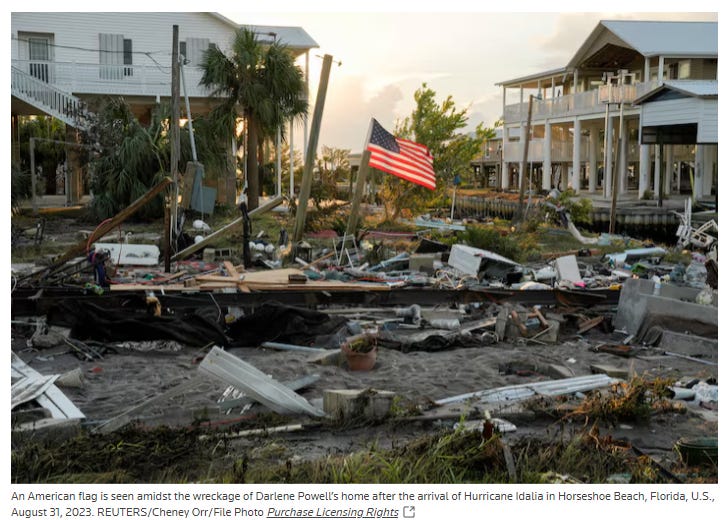🎯100th Post - Looming Property Insurance Disaster
Preview of a longer climate & insurance research report I wrote
Editor's note: Thank you to everyone who follows this page for reading thus far. Today's issue will mark my 100th post for this Substack page, and I couldn't be happier!
Initially, I decided to write only 100 posts and lay the newsletter to rest. Call it a personal exercise to do some brand building. I opted to write a newsletter that only a broker could write - combining the insights I was privy to on the ground floor of real estate deals and some informed analysis on new government mandates and regulations and their impacts on real estate investors. Writing these stories was a lot of fun, so I extended the scope of posts to include analyses of news events, deep dives into housing policy, and deal stories. Two years have passed, and it's become clear that readers enjoy the weekly newsletters, so I will keep them coming, free of charge. Thank you again.
For today’s letter, I summarized some research I did on the twin climate and insurance crises that could spell big trouble. If this piece is well received, I will publish the full write-up next week 🤞.
Significant shifts in the insurance landscape have proliferated since insurance costs have increased due to climate change. Where policy premiums rise precipitously in some communities, some homeowners without mortgages opt to “go naked” and go without insurance altogether. In other instances, insurance companies are entirely exiting markets because the costs of providing insurance coverage to communities are so significant and fraught with risk. These two market reactions can work together in negative feedback loops. If fewer homeowners take on insurance, insurers must charge more to existing policyholders to balance their risks, leading to fewer insured homeowners. Conversely, the fewer insurers in the marketplace, the higher the premiums will typically be for policyholders, which could lead to fewer insured homeowners.
The exit of private insurers in many states and cities and the rising annual premiums have led to the rapid growth of state insurers of last resort. These state insurers are critical means for homeowners to insure their properties that private companies may deem un-insurable. Unless these state agencies know something that other insurance companies don’t and thereby have an advantage in underwriting insurance that competitors deem too risky, they are taking on more risk. On top of that, yearly premiums need to be low enough that the policyholder is willing to sign on. And therein lies the problem – what policyholders pay for insurance in many areas is not commensurate with the insurer’s expected value/cost of the property loss. By failing to share the risk with policyholders because that would lead to costly premiums, state insurers are absorbing a disproportionate share of the property risk. Over time, the unbalanced distribution of insurance risk sharing will lead to disaster when turbulence hits the system.
It is difficult to overstate the importance of property insurance for the development of communities. Colorado State Representative Judy Amabile recently said, “There’ll be no real estate transactions, no businesses, hotels, stores” without affordable insurance, and “Insurance is pretty fundamental to keep things going.” Representative Amabile’s comments ring true because the real estate industry is driven by lending activity and lenders rely on insurance policies to protect their assets before lending on them. Lenders won’t provide credit to markets without insurance, and real estate activity will dwindle. That will impact the private sector and the growth of public goods like schools, hospitals, and government properties. State insurers of last resort know this, which is why they sell otherwise uninsurable policies that effectively subsidize risks on paper, enabling the issuance of mortgages and allowing communities and economies to grow.
Because of the insurance threat, U.S. Senator Sheldon Whitehouse, the Senate Budget Committee chairman, is leading an investigation into Florida’s insurance practice’s potential risks on the broader real estate market’s solvency. He said, “If Florida is the leading edge of the predicted crash in coastal property values, it could lead to an economic meltdown similar to 2008.” The climate disaster data, the rise in insurance costs, and the connectivity between real estate, lending, and insurance drive Whitehouse’s comments. As of 2022, vague estimates indicate a shortfall of approximately $1 trillion nationwide to cover property damage and replacement claims. The looming real estate disaster is just one large hurricane away from millions of “go-nakeds” losing their homes and state insurers of last resort defaulting on their replacement claims. Federal bailouts will be required when that happens, turning localized climate problems into fiscal crises.
Managing climate risks today will not only protect the built environment but also allow the U.S. to avoid the devastating effects that insurance company defaults would have on local communities across the country. The orange haze that obscured Manhattan skylines in the summer of 2023 serves as a visual reminder that climate disaster trends are not stopping—evidence actually suggests that wildfire seasons are lengthening. A climate-driven insurance disaster happens when a wildfire causes damage greater than budgeted state reserves allow for, and suddenly, entire communities cannot secure insurance policies from carriers. When this happens, if nothing is done to change the status quo, access to credit will evaporate, and communities will atrophy. Though it’s impossible to control the tide of natural disasters, it’s well within our abilities to take an interdisciplinary approach to buttress the insurance system so that financial crisis is averted when (not if) disaster strikes.
Sources:
Doug Bailey, “12 % of US Homeowners Foregoing Home Insurance, Study Finds,” September 6, 2023, Insurance Newsnet.
Tim Brockett, Serena Garrahan, Mark Bove, Raghuveer Vinukollu, “The Weather Gauge – Driving Extreme Awareness and Resilience Forward,” Q2, 2023, Munich Re & Insurance Information Institute
Leslie Kaufman, Saijel Kishan and Nadia Lopez, “A Hidden Crisis in US Housing,” March 5, 2024, Bloomberg.com
I am bullish on NYC multifamily. Call me at 212 658 1471.



